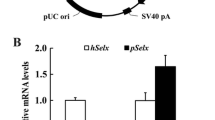Abstract
Mechanisms of selenite cytotoxicity were examined using isolated rat hepatocytes. When selenite was added to a suspension of rat hepatocytes, intracellular reduced glutathione (GSH) was decreased and the oxygen consumption rate was increased. Subsequently, thiobarbituric acid-reactive substances (TBA-RS) and lactate dehydrogenase (LDH) leakage were increased. A ferric iron chelator, desferrioxamine (DF), and a synthetic Superoxide dismutase (SOD) mimic, desferrioxamine manganese (DFMn), reduced the selenite toxicity. These results suggest that Superoxide anion and its reactive metabolites such as the hydroxyl radical may be involved in the cytotoxicity of selenite.
Similar content being viewed by others
References
Anundi I, Ståhl A, Högberg J (1984) Effects of selenite on O2 consumption, glutathione oxidation and NADPH levels in isolated hepatocytes and the role of redox changes in selenite toxicity. Chem Biol Interact 50: 277–288
Batist G, Katki AG, Klecker Jr RW, Myers CE (1986) Selenium-induced cytotoxicity of human leukemia cells: interaction with reduced glutathione. Cancer Res 46: 5482–5485
Bell RR, Nonavinakere VK, Soliman MRI, Early II JL (1991) Effect of in vitro treatment of rat hepatocytes with selenium, and/or cadmium on cell viability, glucose output, and cellular glutathione. Toxicology 69: 111–119
Darr D, Zarilla KA, Fridovich I (1987) A mimic of Superoxide dismutase activity based upon desferrioxamine B and manganese (IV). Arch Biochem Biophys 258: 351–355
Dougherty JJ, Hoekstra WG (1982) Stimulation of lipid peroxidation in vivo by injected selenite and lack of stimulation by selenate. Proc Soc Exp Biol Med 169: 209–215
Ganther HE (1966) Enzymic synthesis of dimethyl selenide from sodium selenite in mouse liver extract. Biochemistry 5: 1089–1098
Ganther HE (1968) Selenotrisulfides. Formation by the reaction of thiols with selenious acid. Biochemistry 7: 2898–2905
Ganther HE (1971) Reduction of the selenotrisulfide derivative of glutathione to a persulfide analog by glutathione reductase. Biochemistry 10: 4089–4098
Ganther HE, Corcoran C (1969) Selenotrisulfide. II. Cross-linking of reduced pancreatic ribonuclease with selenium. Biochemistry 8: 2557–2563
Garberg P, Högberg J (1987) The role of hypoxia in selenium metabolism. Biochem Pharmacol 36: 1377–1379
Garberg P, Ståhl A, Warholm M, Högberg J (1988) Studies of the role of DNA fragmentation in selenium toxicity. Biochem Pharmacol 37: 3401–3406
Högberg J, Kristoferson A (1977) A correlation between glutathione levels and cellular damage in isolated hepatocytes. Eur J Biochem 74: 77–82
Hsieh HS, Ganther HE (1975) Acid-volatile selenium formation catalyzed by glutathione reductase. Biochemistry 14: 1632–1636
Imanari T, Hirota M, Miyazaki M, Hayakawa K, Tamura Z (1977) Improved assay method for Superoxide dismutase. J Clin Exp Med (Igaku No Ayumi) 101: 496–497
Imura N, Naganuma A (1978) Interaction of inorganic mercury and selenite in rabbit blood after intravenous administration. J Pharm Dyn 1: 67–73
Landenstein R, Epp O, Bartels K, Jones A, Huber R, Wendel A (1979) Structure analysis and molecular model of the selenoenzyme glutathione peroxidase at 2.8 Å resolution. J Mol Biol 134: 199–218
McNeil TL, Beck LV (1968) Fluorometric estimation of GSH-OPT. Anal Biochem 22: 431–441
Naganuma A, Imura N (1980) Bis(methylmercuric) selenide as a reaction product from methylmercury and selenite in rabbit blood. Res Commun Chem Pathol Pharmacol 27: 163–173
Ohkawa H, Ohisi N, Yagi K (1979) Assay for lipid peroxides in animal tissues by the thiobarbituric acid reaction. Anal Biochem 95: 351–358
Ray JH, Altenburg LC (1978) Sister-chromatid exchange induction by sodium selenite: dependence on the presence of red blood cells or red blood cell lysate. Mutat Res 54: 343–354
Seko Y, Saito Y, Kitahara J, Imura N (1989) Active oxygen generation by the reaction of selenite with reduced glutathione in vitro. In: Wendel A (ed) Selenium in biology and medicine. Springer, Berlin Heidelberg New York, pp 70–73
Shamberger RJ (1983 a) Biological interactions of selenium with other substances. In: Shamberger RJ (ed) Biochemistry of Selenium. Plenum, New York London, pp 125–166
Shamberger RJ (1983 b) Toxicity of selenium. In: Shamberger RJ (ed) Biochemistry of selenium. Plenum, New York London, pp 185–206
Snyder RD (1987) Effects of sodium selenite on DNA and carcinogeninduced DNA repair in human diploid fibroblasts. Cancer Lett 34: 73–81
Thomas CE, Morehouse LA, Aust SD (1985) Ferritin and superoxide-dependent lipid peroxidation. J Biol Chem 260: 3275–3280
Whiting RF, Wei L, Stich HF (1980) Unscheduled DNA synthesis and chromosome aberrations induced by inorganic and organic selenium compounds in the presence of glutathione. Mutat Res 78: 159–169
Wróblewski F, LaDue JS (1955) Lactic dehydrogenase activity in blood. Proc Soc Exp Biol Med 90: 210–213
Young JD, Crowley C, Tucker EM (1981) Haemolysis of normal and glutathione-deficient sheep erythrocytes by selenite and tellurite. Biochem Pharmacol 30: 2527–2530
Author information
Authors and Affiliations
Rights and permissions
About this article
Cite this article
Kitahara, J., Seko, Y. & Imura, N. Possible involvement of active oxygen species in selenite toxicity in isolated rat hepatocytes. Arch Toxicol 67, 497–501 (1993). https://doi.org/10.1007/BF01969921
Received:
Accepted:
Issue Date:
DOI: https://doi.org/10.1007/BF01969921




